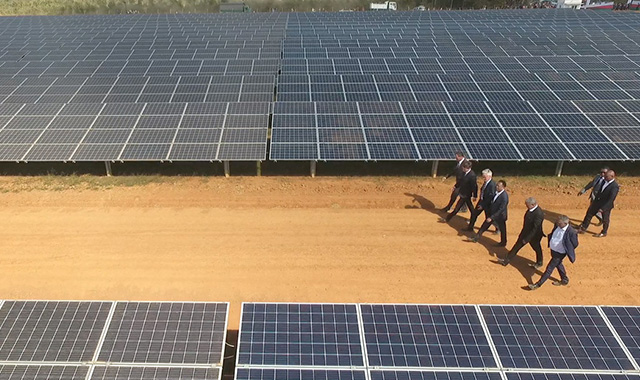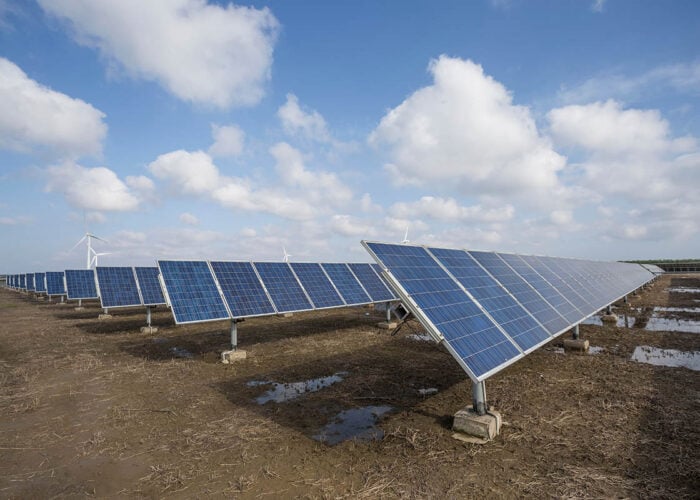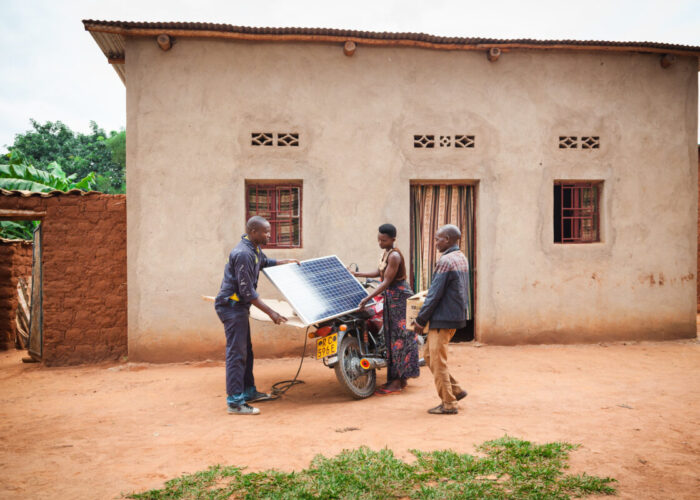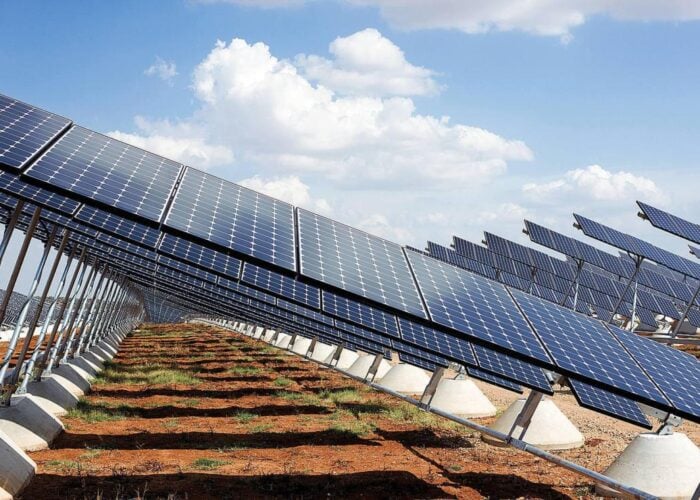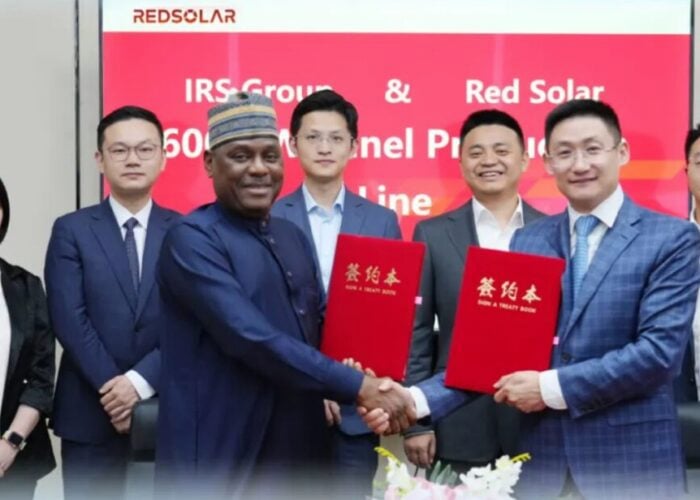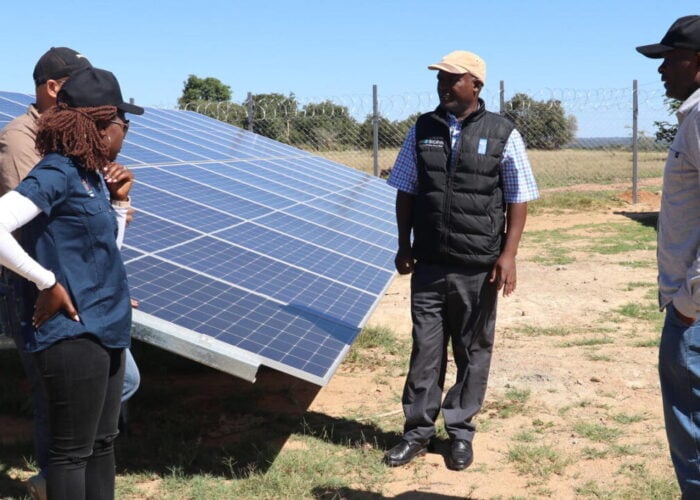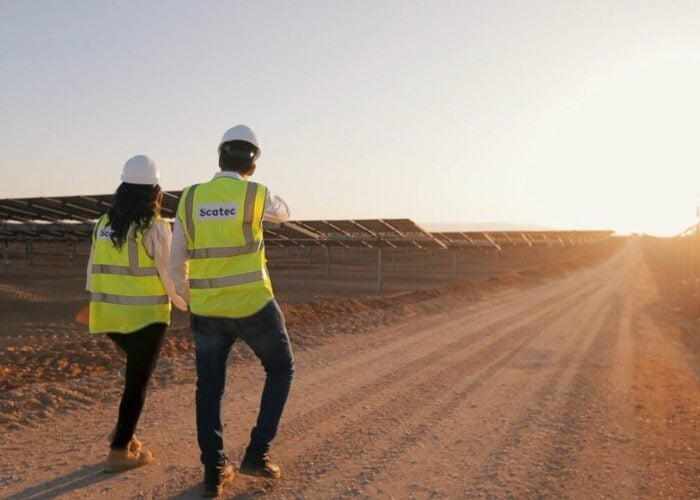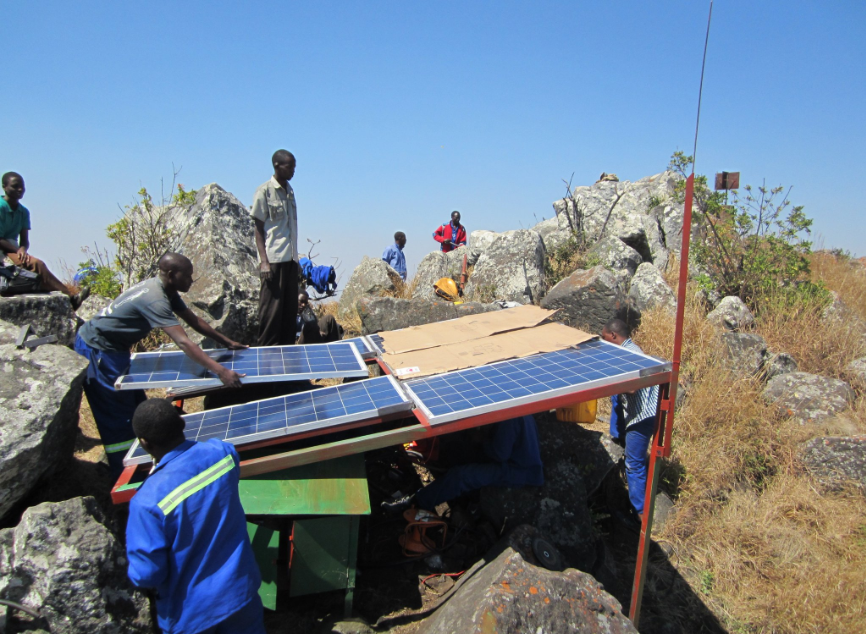
Life in the Sahel, a semi-arid region of Africa stretching from the Atlantic Ocean to the Red Sea, is at threat from persistent degradation of land as the increasing population inflicts ever-greater pressure on resources. According to Sweden-based think tank, Eden Foundation, which has been active in the Sahel for 30 years:
“Desertification is a man-induced process that leads to soil nutrient depletion and reduction of biological productivity. In the Sahel slashing and burning of natural forest and bushland in order to clear land for annual agriculture is the main cause of this destruction. Farmers continue to degrade their environment in the agricultural zone even after the decimation of perennials [trees, shrubs and plants which flower reliably every year].”
Unlock unlimited access for 12 whole months of distinctive global analysis
Photovoltaics International is now included.
- Regular insight and analysis of the industry’s biggest developments
- In-depth interviews with the industry’s leading figures
- Unlimited digital access to the PV Tech Power journal catalogue
- Unlimited digital access to the Photovoltaics International journal catalogue
- Access to more than 1,000 technical papers
- Discounts on Solar Media’s portfolio of events, in-person and virtual
As somewhat of a distraction, an idea that the Sahara Desert has been descending south across the Sahel over time, caught the imagination of certain leaders more than a decade ago and led to a plan to build a giant blockade of trees running across the southern edge of the desert from Senegal in the West, to Djibouti in the East. However, the ‘Great Green Wall’, an African-led project spread over 8,000 kilometres in one of the most underprivileged regions on earth, was naïve and simplistic, says Gray Tappan, Geographer at the US Geological Survey, who studies satellite imagery of the Sahel.
Greening not descending
“If you look at satellite images that measure the greenness of the landscapes through a vegetation index, if anything the desert is in a sense retreating and the Sahel has really been greening up a bit,” adds Tappan. “What is happening: it’s a part of the world where there are more and more people every year, West Africa is the fastest growing human population in the world, with Niger being the head of the group, with population doubling roughly every 20 years, so we are seeing increased human pressure on the natural resources including trees and wood, so it’s a mixed story.”
Nonetheless, a return to planting and preserving trees rather than cutting them down is crucial as the satellite greening often means growth in unsustainable cropland rather than trees and vegetation (See Boxout on desertification at end of this Article). Off-shoots of the Great Green Wall project that also focus on planting trees are seen as a chance to mitigate the worst impacts of climate change, to counter potential drought and reduce the chance of conflict over dwindling natural resources. They are even touted as a chance to create employment opportunities that could reduce the cavities left by swathes of youth emigration.
However, a widespread lack of access to electricity has meant that trees are also a primary source of fuel for many of the local people. This paradox means that tree preservation efforts are fighting an uphill struggle against the human consumption of wood for essential day-to-day living. While rural areas demand firewood, the cities of West Africa are hungry for charcoal.
“That’s huge,” says Tappan. “It is really hitting the remaining woodlands and tree savannahs of West Africa, it’s really hitting them hard.”
The ‘Great Charcoal Wall’
Thus, if the people of the Sahel are not given access to renewable energy sources, then the figurative great wall of trees could be transformed into a literal ‘Great Charcoal Wall’, as the president of one bank is reported to have quipped.
Michael Keating, executive director, European Institute of Peace, and former UN Special Representative of the Secretary-General for Somalia, a country at the far Eastern end of the Sahel, says that the main sources of energy for most of the population are biomass, wood and charcoal, all of which are problematic for different reasons.
“Biomass, a combination of environmental degradation and climate change in a country which is still primarily nomadic and agricultural is a disaster and it means that there is more competition for natural resources and that is contributing to conflict,” adds Keating. “Charcoal has also become a source of income in illicit economic activity. Al-Shabaab, the insurgency, is using revenues from charcoal to finance itself so that is a problem.”
Keating says that although clean energy has not yet been proven to contribute to peace and reconciliation, his instinct suggests that it does. Meanwhile, local attitudes have also been favourable to the adoption of solar.
“Everybody is up for it,” says Keating. “There is nothing negative about it. The sky is the limit.”
‘Desert to Power’
The threat of a ‘Charcoal Wall’ is partly why in January this year, the African Development Bank (AfDB) conceived of a huge electrification plan across the Sahel region, targeting a mammoth 10GW of solar capacity by 2020 that it claims could provide power to 250 million people and reduce deforestation driven by fuel-poverty. The so-called ‘Desert to Power’ programme, which uses a combination of grid-connected and off-grid solar photovoltaic (PV) technology, would see AfDB support renewable energy proliferation in Sahel countries that until now have either lacked regulation and policy drivers or suffered from a chronic lack of willing financiers. The bank is still coordinating how to procure and deliver this technology deployment but is eyeing a mix of public and private routes, delivered either through state-run utilities or international developers.
I’ve seen Geo Maps of the Sahara and West Africa it’s just startling to see the changes over a decade from 1980 to what it looks like in 1990 and up to the present day.
William Fiebig, an independent consultant in climate-smart agriculture, who has worked with 186 communities across seven African countries, also says that solar has the power to “transform the rural economy” and offer improvements in education, agriculture and access to journalism that otherwise wouldn’t be possible. Meanwhile, the increasing desertification of the region has become an unnerving driver for such action.
Fiebig and other organisations with lengthy experience in agricultural practices of the region warn that it is critical to define the precise applications of any solar power systems before touting any supposed benefits for the local communities.
Not everyone is convinced that solar energy can significantly improve living standards in the Sahel in the way it has been imagined. For example, Staffan Göranson, chairman of the board at Eden Foundation, says that to date he has not seen the translation of deployment of various solar products into added well-being for the poorest sections of society, particularly where sourcing food is the absolute priority. When it comes to solar-power irrigation pumps, he admits that solar is probably the most suitable energy technology, but he has serious concerns about the effects of irrigation on groundwater levels in a region of such delicate water supply as the Sahel. For Göranson, more effective action can be taken with various seed programmes, that take some time to literally bear fruit, but which can also see trees providing food to people even in a year with minimal rainfall, he claims.
Some have also warned of the potential for the wealthier locals to take most of the benefits of solar with less urgent frills such as improved air conditioning, perhaps to the disregard of the poorest farmers whose absolute priority is often food not power, particularly in the barren Sahel. However, rapid advancement in solar technology and reduced costs have to be considered and as Keating has mentioned, replacing fossil fuels with clean energy could be a key factor in reducing conflict and even extremism.
World’s ‘largest’ solar power system zone
AfDB’s vision for 10GW of solar would, in any case, impact most echelons of society. The off-grid solar targets, which tend to focus on remote rural areas, are only a part of its grander strategy, which includes large, utility-scale solar plants to power towns and cities. The bank aims to tackle traditional African development problems through public funding and dialogues with central governments, says Ousseynou Nakoulima, who as director of Renewable Energy and Energy Efficiency at AfDB, is in the process of sending swat teams out to select countries to assess their readiness and potential for solar deployment.
“Everything that I’m saying in this conversation is about achieving speed and scale,” adds Nakoulima. “Because so far if you look in the past into this sector, things have been done in a very isolated and a very protracted way.”
The countries being considered at present are: (from West to East) Mauritania, Senegal, Mali, Burkina Faso, Niger, Nigeria, Chad, Ethiopia, Eritrea, Sudan and Djibouti. All the countries are well-endowed with high levels of solar irradiation and the worldwide price reductions in solar PV equipment mean the time is ripe for kick-starting PV across Africa, not just in the Sahel. A 20MW utility-scale project was completed by a Chinese firm named BXC in Ghana two years ago at a time when most Sub-Saharan Africa solar plans were nothing more than ideas held up in early stages of development, without finance, without PPA signings and without any flagship projects to learn from. That’s all changed in the last year with significant-sized projects announced for many Sub-Saharan African countries including a 50MW project in Burkina Faso that was backed by AfDB.
A major boost to the bank’s Sahel plan also came in late May when the Green Climate Fund (GCF) and the Africa50 investment fund announced they would be collaborating with AfDB to share ideas and resources on this ‘Desert to Power’ programme.
The African Development Bank (AfDB) has said that it expects its Sahel projects to become the ‘largest solar power system zone in the world’ once completed. Individual projects are unlikely to match up to the 2-5GW solar parks rising up locations like India, Egypt and the UAE, but the breadth of geography AfDB wants to cover makes fulfilling the ‘Desert to Power’ vision a grand task in itself.
The Method
The 10GW goal is designed to create an order of magnitude or sense of potential in the region that would trigger a number of benefits such as creating a sizeable market for solar manufacturers, project developers and investors. However, while contemplating the task at hand and hoping to build momentum, Nakoulima is keen to maintain a sense of realism:
“How do you eat an elephant? It’s just one bite at a time.”
Understanding political dynamics in Africa is also pivotal, adds Nakoulima. Even though there is some level of integration at the sub-regional level, countries are still very attached to their sovereignty, which means regional programmes cannot be carried out without addressing the national priorities and the national circumstances.
Burkina Faso’s political will
When AfDB first tested the water by entering Burkina Faso in partnership with French development bank Agence Francaise de Développement (AFD), under its ‘Yeleen Programme’, the bank was pleasantly surprised to find strong and organic political will to harness solar for the development of the country.
The financier’s actions in Burkina Faso then formed the blueprint for how it would assess each country henceforth. This included evaluating the current political and economic environment, accounting for both long- and short-term ambitions and then immediately attempting to drive solar investment.
Having assessed the state of Burkina Faso’s electricity grid, the bank decided to plan 1GW of solar PV capacity even though the present grid could not absorb that level of additional power. This approach came with good reason. Waiting for grid improvements before deploying solar could delay projects by 3-4 years, so AfDB aims to deploy solar in small increments straight away, starting with 50MW in the first phase and an additional 50MW to follow quickly, while simultaneously backing transmission upgrade activities.
The first phase 50MW project will be developed in partnership with a local utility but at the same time the country is engaged with some private players to encourage private power projects, says Nakoulima. As part of the project financing, the bank is also supporting the North Dorsal electrification project, a plan to connect Burkina Faso with Nigeria, Niger and Benin. This is a clear example of promoting solar with simultaneous work on grid capacity and power distribution.
Adiaratou Bah, principal investment officer at AfDB and coordinator of the ‘Desert to Power’ scheme, says the Yeleen Programme aims to increase supply and energy independence, lower the cost of energy and reduce greenhouse gas emissions through three components, namely:
- Development of grid-connected PV plants (one large 40MW plant and six small 1-2MW plants);
- Strengthening the electricity transmission network, by introducing electricity storage, energy control centres and developing the distribution network. The bank is also mobilising funds from the European Union to address these grid constraint barriers;
- Rural electrification using mini-grids and individual Pay-As-You-Go (PAYG) solar systems.
In total the fast track phase of Yeleen programme aims at developing 70MW of electricity through solar PV plants on-grid and off-grid.
The AfDB also has primary responsibility for Yeleen’s rural electrification component that aims to electrify 50,000 households and adjacent community infrastructure in schools, health centres, and community water pumps, among other locations.
Megawatt by megawatt
Roadshows in other Sahel countries will facilitate dialogues between the bank and developers to help identify bottlenecks and to ascertain what developers perceive as a risk and vice versa. Elite teams have already been sent on identification missions to Mauritania, Mali, Senegal and Chad, with an on-going mission in Niger this month, as a first step before launching programmes in these countries.
“What I don't want to do is have a theoretical program and no megawatts on the count,” says Nakoulima. “So the approach we adopted; we build it from the ground up, we have a vision, but it’s not about having a top-down approach where you build a very complex architecture and try to apply it to countries. No, it’s conveying the vision, giving the signals to all players, but starting from the outset in each country megawatt by megawatt.”
As a financier rather than developer, AfDB will be providing funding but, as process at a country level is a concern, it will also help governments to form procurement plans, such as tendering out capacity for public sector projects. The bank can then use its ‘Africa legal support facility’ to help review standard power purchase agreement (PPA) documents.
Nakoulima says that once studies are approved and financing secured in Burkina Faso, then the country will launch a tender to have an EPC contractor come and develop the project, but AfDB and the government are still discussing the model they want to adopt.
Challenges
To date, adding capacity in any of these countries has been a tall order and Nakoulima repeats that projects currently being financed in Africa have often taken five years to develop. Nigeria, for example, which had multiple large-scale projects of greater than 40MW in size held up for several years, took until July 2016 to sign nearly 1GW worth of power purchase agreements (PPAs) all in one go with ten project developers.
“Even if you put financing on the table, countries cannot absorb this financing because for instance the grid capacity is a challenge,” says Nakoulima. “Secondly, the time tenders take to be finalised – even for an IPP it is quite daunting – so there are a number of hurdles and when we thought about this programme, we thought about really addressing first and foremost this challenge.”
Another problem is risk perception and the difficulty of managing administration. Developers don't know which departments to approach in the various energy ministries and they often believe they need to see the country’s president for action to be taken. For this reason, AfDB is trying to facilitate the necessary dialogue between public sector and private sector.
Hardest but counts the most
The big grid-connected projects always grab headlines, but in the context of tree-cutting and the supposed threat of the ‘Green Wall’ being turned to charcoal, AfDB’s off-grid plan out in the remote rural areas will need a similar level of focus. Nakoulima readily admits that these off-grid projects are “the most difficult part of the equation”.
It’s too early to say just how much budgeting will go towards this segment, but initial estimates suggest that at least 90 million people could be reached by off-grid PV systems. Low incomes in these countries mean that special payment methods must be devised to make solar accessible to the poorest sections of society. Uptake of solar has traditionally been barred by the high upfront costs of a PV installation, but pay-as-you-go (PAYG) and third-party ownership models have helped to alleviate this problem.
“It’s a question of access and what kind of credit plan can you provide,” says Fiebig. “I’ve seen it work in seeds. That’s why I say if the technology is there and when improved varieties and seeds of those varieties become available, farmers and smallholders will find a way to purchase them and believe me if they can get a solar panel to put on their grass hut so they can have a light bulb in the evenings for their kids to be able to do some homework… they’ll figure out how to use it.”
AfDB is itself testing a few of these payment models before it puts its full weight into the off-grid programmes. A specific model will be defined for each country and project, usually through mobile phone operators. It has experience helping countries develop green mini-grid policies combined with helpdesks and assessments of market potential. It has also backed solar home systems in Togo, a West African country that lies outside the Sahel belt, through its ‘Cizo’ scheme.
Nor is solar the only way to cut wood usage; Fiebig says improved cooking stoves, which are rarely included in rural development programmes and projects, should be scaled up.
“The cost and benefits are incredible in so many ways,” he adds. “Bottom line is that the amount of wood fuel consumed in one day's cooking on the traditional open-air fire – the same amount of fuel-wood would provide cooking fire for four days in an improved stove.”
Projections from the International Food Policy Research Institute (IFPRI) show how carbon emissions from wood fuel cooking can be seriously curtailed with these improved stoves, specifically in Ethiopia in this case:
Social impact
When describing the key goals of the 10GW target, Nakoulima is confident that several social issues stemming from a lack of in-country development can be mitigated by solar power, particularly in rural areas where economic activity is stunted by poor access to electricity and compounded by a widening sinkhole of emigration.
A key goal on the off-grid solar side is mitigating the impacts of climate change, because these countries have witnessed a steady change in rainfall patterns over recent years and to remain self-sustained in terms of food and agriculture, farmers will have to adapt.
“If they cannot rely entirely on rainfall you need to develop irrigation, which needs power and if you think about power, the easiest way is solar PV,” says Nakoulima. “So all these combined give a strong rationale for us to devote enough effort and resources to this key enabler which is deploying solar generation in these countries.”
Combined with solar deployment, education is also required to spread good practice in farming. For example, Fiebig has travelled Africa encouraging farmers to grow crops that are more resilient to the increasingly unpredictable and extreme weather phenomenon that are set to come hand-in-hand with climate change. Reliance on individual cash crops such as Maize in Western Africa, for example, leaves farmers more exposed to higher temperatures and flooding, while higher carbon dioxide levels can also impact nutrient levels in many staple foods. The focus has to shift from cash crop to climate-smart agriculture.
Göranson is concerned specifically about irrigation, which he says can increase salinity at the surface of the farmland making it increasingly hard to grow food as time goes on, while in extreme cases irrigation could even empty the waterboard.
“Power for irrigation is totally wrong in my eyes,” he says. “I think it’s a bluff. It doesn’t work. You can drill the wells but you will take away the groundwater if you do that in a large-scale. There’s a huge risk on that. We believe that if they can grow trees that give food, it will motivate them – we have proven it for 30 years. I am not against [solar] in itself but for the poor farmers it's no help.”
Göranson cites Niger as an example where the unemployment rate is 70% and he does not see how solar can benefit this section of society. He also looks back on 20 years of what he describes as undelivered promises in the region from a range of technologies and vendors, but not just solar PV.
In response to concerns that solar power for irrigation in the Sahel region may cause long-term salination of the top soil and seriously affect ground-water levels, AfDB’s Adiaratou Bah claims that the Bank has a strong due diligence process whereby each project to be supported and financed by the Bank must be duly analysed by the project teams including technical, legal, financial and any other required expertise – adding: “Thus any project undertaking solar power for irrigation, supported or financed by the Bank, will have to be cleared by the relevant expert for that sector.”
Meanwhile, in contrast to Göranson, Nakoulima claims that many people are suffering from malnutrition in the Sahel partly as a result of energy insecurity, so he says every dollar spent on off-grid solar can improve people’s lives, and certainly in an even more impactful way than many utility-scale solar projects.
“Even though urban areas are growing in terms of population, rural areas are still very populated and you have very few successful business models that work,” adds Nakoulima. “So one part of our mini-grid programme is to see how we can combine investment in energy and investment in agriculture so that we can induce a positive feedback loop.”
Fiebig also believes that Africa is ready for solar, with its potential to transform rural economies and especially when it addresses community access to solar pumps for potable drinking water. Ultimately, it depends largely on whether the policymakers are on board and this is where the ambitious ‘Desert to Power’ programme, with the AfDB’s financial clout, could make a difference.
Desertification in the Sahel – A geographer’s view
Gray Tappan, Geographer, US Geological Survey, EROS (Earth Resources Observation and Science Center) explains what Satellite imagery tells us about the state of land in the Sahel, in his own words:
Gray Tappan: The whole notion of the deserts expanding and moving southwards is really a myth in a sense. It’s a popular way of presenting it that way in the media over decades. But there really isn’t an advancing front that you can see or map. Nature is more complicated and it just doesn’t work that way.
Mostly the recent greening from the satellite imagery is the immediate response of grass production and cropland to rainfall, not so much trees. But so far as the trees go, that’s really the long-term indicator of what’s happening.
The true story is more cutting of trees by a rapid growing population, both for wood fuel and cooking needs.
The Sahel and West Africa, in general, are getting hammered by increasing areas of cropland where there were not crops before. It’s going to mono-culture or rotation of peanuts and millet, while expanding crop into natural landscapes, the woodlands and the tree savannahs that’s really driving the change. It’s a major transformation of the land and they are not leaving many trees behind, laying the land bare for wind and water erosion. Again, it’s not the Sahara expanding at all, it’s the increasing population.
Desertification
The definition of desertification is land losing its ability to sustain life, to produce vegetation cover, habitat for wildlife, it's all basically being removed. The productivity of the land is severely degraded along with its ability to produce vegetation cover and habitat and therefore food for people and wildlife.
Rather than the desert expanding southwards, it’s more like a cancer in a way. It’s very spotty and localised and it’s a combination of drought years (going back to the 70s and 80s) low rainfall and increased human pressure. It's usually a combination of the two that result in these very localised areas and I’m talking localised by a few square kilometres here and there, but nothing wider or broader than that.
It’s very spotty and patchy because of the very intense human pressure. It takes more than drought to create desertification – it’s a combination of drought, which is a widespread phenomenon geographically and this very focused pressure of humans and livestock. Typically, it’s concentrations of livestock around a waterhole, and a lot of wells are being drilled today that didn’t exist before. They tap into deep aquifer water, bringing that to the surface for tens of thousands of livestock and so that concentration with people can basically wipe out the grass and tree cover and open up the soil for erosion, and so what we see is desertification in these spots.
Climate Change
There are localised droughts – there always are – it’s an area of high variability in rainfall but nothing like the multi-year droughts that wiped out livestock etc., in the major droughts of 1669-74 and 1982-84. There have been years of pretty good rain and there is tremendous resilience in the Sahelian semi-arid eco-systems. So the good news is that if you take the pressure off a little bit, you do see the vegetation coming back.
There is sign of climate change, but it is still not dramatic, the farmers see it, we see it. The start of the rainy season is shifting later by a month to six weeks and ending later. It may also be getting a little shorter so that’s a concern. The variability of the rain seems to be increasing a little bit and yes the temperatures are starting to go up so that’s a problem because higher temperatures means more evapotranspiration meaning that the moisture that you do have doesn’t go as far in terms of crop growth. When it’s getting hot, your evapotranspiration goes up, so stress whether it’s for humans, animals or plants goes up too.
But for now, the elephant in the room, the big picture, is the human population and the expansion of cropland and increasing demand for wood fuels.
One of Africa’s ‘greatest success stories’
There’s a very positive story that is the re-greening of the Sahel, which has nothing to do with increased rainfall or the Great Green Wall idea.
Really it’s the fact that hundreds of thousands of farmers particularly across Niger and Mali and Burkina Faso have decided that trees on farms are really important. There are many benefits to having trees on their farmland and so the big story is that rather than plant trees which are prone to failure (trees die, they especially need care and watering), farmers are allowing the trees to regenerate naturally from seed or from roots in their fields and on their farmland and rather than cut them down and keep their fields open and clean for cultivation like ploughing. They have now changed the picture to have as many trees on their farmland as possible and hundreds of thousands of farmers started doing that in the mid-1980s.
In an area of settled farmers in Niger, for example, there are 5-6 million hectares of farmland with far more tree cover today than 30 years ago and our pictures show that. That’s 40-60 trees per hectare over vast areas that just weren’t there and the value of those trees is huge. Again it addresses the wood fuel issue, as they don’t just cut the trees down for firewood, they lop them and prune as needed.
We consider it one of the greatest success stories to come out of Africa anywhere in the last 30 years.
